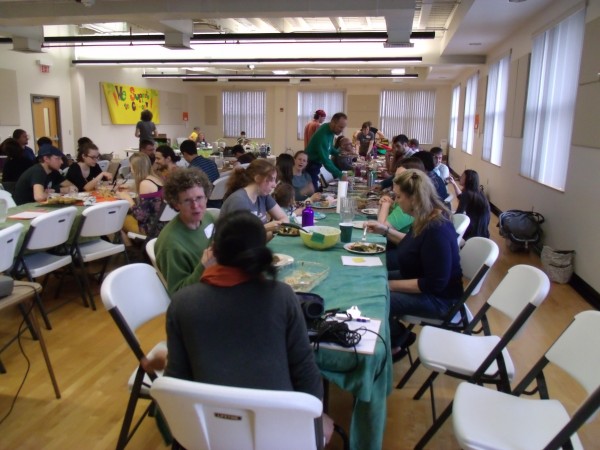-

Erin Donahue -

Christina Barkanic -

Brittany Trott -

Emily Wiley -

Jessica Reilley -

Chris Raines -

Will Nichols -

Emily Reddy -

Michele Marchetti -

Michele Frank -

James Gherardi -

Kit Henshaw -

Christina and Erin -

Kim Tait -

Erin McKinney -

Steve Spanelli -

Sam Komlenic -

Katherine Taylor Grofic -

James Eisenstein -

Jamie Oberdick -

Anna Lombardo -

LacCreta Holland -

Tony Ricci -

Local Food Journey -

Laura Young -

Kristin Camplese -

Harrison's Fresh + Local -

Danielle Matalonis -

Kristine A. -

Linda Weaver -

Naomi Elle Schwartz -

Dana Stuchul -

Cara McShane -

Brittany Smith -

Jessica Illuzzi - Frosty
-

Jessica Paholsky -

James Sechrengost -

Brad Yeckley -

Maya Althouse -

Jordan Reabold -

Kim Chase -

Maria Bryant - Alexandrea Scott
My Local Food Fantasy Revisited: Part Two
Posted by James Eisenstein on 04/19, 2013 at 01:19 PM

A community pot luck supper was held April 16 to celebrate the incorporation of the local food organization Friends and Farmers.
Editor’s note: You can read Part One of this post here.
What would a local food system look like? Unless really hard times come when we are unable to import anything, we are likely to continue to draw upon distant sources for such things as olive oil, citrus fruit, avocados, pistachios, and high fructose corn syrup (just testing to see if you are paying attention on that last one).
But how much of what we eat could be produced locally? It turns out, a surprising variety of foodstuffs could come from our own backyard. We already have fairly large producers of pasteurized milk (Meyers Dairy), apples and other fruits (Way Fruit Farm and Harner Farm, among others), and potatoes (Ardry Farm). Many other items are available in smaller quantities through Harvest Share Programs (CSAs) and farmers markets, including organic and non-organic vegetables and small fruits, fresh herbs, pastured meats, pastured raw milk, raw milk cheeses (cow and goat) and other milk-based products (think yoghurt), free range eggs, flowers, breads and other baked goods (Gemelli’s, Gaffron’s, and others), jellies and preserves, maple syrup and honey, nuts, and beer. In addition, conventional supermarkets (Wegman’s in particular) feature some “locally†produced items, though their definition of local can be pretty broad. And local (not national chain!) restaurants are also expanding their use of local foods.
Other food is grown locally but shipped to markets hundreds of miles away. As a good hard look out a car window shows, our region can grow wheat and other grains, oil seeds (sunflowers), dried beans, and soy. With the appropriate infrastructure (a grain mill, an oil press, a facility to make tofu, a USDA-approved slaughterhouse), these products could also be local.
So we are blessed with the demonstrated capacity to grow locally food that can provide us with a diverse and healthy diet. Supplies of many are limited now, obviously, but the obstacles to producing more can be addressed (a topic for another blog). The price of these foods produced locally is a problem, but not as significant as commonly assumed, especially for folks interested in the freshness and nutrition of what they eat.
Penn State defines “local†as coming from anywhere in Pennsylvania. Some supermarkets call anything that can be delivered by a truck in one day local, a real stretch given the Bud Shuster highway and other thoroughfares. Lancaster County and Erie aren’t exactly in our backyard. My rule of thumb is about an hour and a half drive or 75 miles from here. A shorter distance would limit the potential growth of output due to the high cost of farmland near State College.
Right now, you can buy nearly everything you eat (yes, with some exceptions) at a local farmers market during at least part of the year. As farmers expand their use of season-extending technologies like high tunnels, you will be able to become a near year-round localvore. When the Friends and Farmers Food Coop opens, accessing local foods will become more convenient, and with its support, the amount and variety of products will increase. I think it’s going to happen.
![]() Author: James Eisenstein
Author: James Eisenstein
Bio: Unpaid Field Hand at Jade Family Farm | Former Penn State Professor
- Our Local Food Journey comes to an end
- Winter isn’t a quiet time at the farm
- Get the taste of garden season right now by growing herbs indoors
- All you need to know about PASA’s Farming for the Future conference









NO COMMENTS